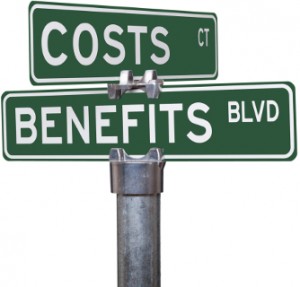Editor’s note: This is the third piece in a series looking at the fact that while Americans enjoy a lower overall tax burden than that of the citizens of other wealthy countries, we also pay four times as much as they do, on average, for out-of-pocket “social costs” in the private sector – health care, retirement security, disability and unemployment insurance and the rest of the social safety net. When you add up what we pay in taxes and what we pay out of pocket, Americans spend about the same share of their economic output on social costs overall as the citizens of some of the most generous, heavily taxed social democracies, but we a get far less secure safety net in return. You can read part one here, and part two, which focuses on health care spending, here.
Americans’ heavy reliance on the private sector to provide social goods and services doesn’t only result in us paying a lot and getting a lot less for it, compared to other wealthy countries. It also makes the financing of our entire social welfare system far less fair. It’s a great deal for the wealthiest, and a huge rip-off for the rest of us.
To understand how, we’ll need some background.
A Nasty Little Myth
The most pernicious myth in American politics holds that only around half the population pays taxes. Sean Hannity put it like this: “If half of Americans pay taxes, and the other half are the beneficiaries of the tax that the other half pay, at some point you say, OK, you got a full voting bloc.” In a call to raise taxes on the poor, Sen. Dan Coates (R-IN) said, “I think it’s important that this burden not just fall on 50 percent of the people but falls on all of us in some form.” He added, “Everyone needs to have some skin in the game.”
The narrative is the epitome of cherry-picking. While 43 percent of households won’t need to pay federal income taxes this year, that’s nothing more than a bit of tax trivia. Federal income taxes make up around 40 percent of federal revenues and a quarter of all taxes paid in this country, while payroll taxes – which virtually all working people pay – also make up around 40 percent of federal revenues (in 2011 and 2012, revenue from the payroll tax represented a smaller share due to the temporary tax reduction in effect during those years).
And the irony is that many households pay no income taxes as a result of a policy that conservative politicians have long favored. As David Cay Johnston, author of Perfectly Legal: The Covert Campaign to Rig Our Tax System to Benefit the Super Rich–and Cheat Everybody Else, told Moyers & Company in October, the situation is primarily due to the child tax credit Republicans put in place in the ’90s. “A married couple with two children does not pay any federal income taxes until they make at least $44,000 a year,” said Johnston. “And with a little bit of tax planning, you could make $70,000 and pay no federal income tax. So the Republicans create this situation where middle-income families with children pay no income tax and then they complain about it.”
That working couples with kids making up to $70,000 are routinely shamed as deadbeats and freeloaders says a lot about the nature of our political discourse regarding these issues.
Some Taxes Are More Progressive Than Others
But cherry-picked facts about federal income taxes are just part of this story. Most Americans believe that we have a progressive tax system overall – that the rich pay a larger share of their incomes than the poor. But that’s only really true when it comes to federal taxes. In fact, according to a 2008 study by the Organization for Economic Cooperation and Development (OECD), our federal tax system was the most progressive of the 24 countries researchers examined (XL).
And state and local taxes are the opposite, with poorer people paying a larger share of their incomes than the wealthy. This chart, prepared by the Tax Foundation, tells the tale…
 Keep this chart in mind the next time you hear someone saying that we should leave all sorts of government programs up to the states.
Keep this chart in mind the next time you hear someone saying that we should leave all sorts of government programs up to the states.
Rip-off
When we pay four times the OECD average for social benefits out-of-pocket – with both a minimum wage earner and a billionaire picking up those costs dollar-for-dollar – it means we’re financing far fewerof these benefits through our progressive federal tax system.
The most prominent example is health care. As we saw in the second part of this series, across the OECD countries, governments pick up 72 percent of the tab for health care, but our government finances just under 48 percent. Only the Chilean government covers a smaller share (XL).
That means that over half of all health care dollars are financed through a combination of direct out-of-pocket spending and private insurance, with working people paying a hefty share of the premiums. So a billionaire pays a dollar for a dollar’s worth of out-of-pocket health care, and so does a struggling wage-slave living paycheck to paycheck. In other wealthy countries, a far larger share is financed through national tax systems. And in our case, the end result would be a revenue stream that is quite progressive.
Another example: We rely more heavily on private, 401(K)-style retirement accounts to see us through our golden years than any other OECD country. Only Canada, Ireland and the UK even come close (XL). Here, again, we see our retirement security dependent on what we can sock away ourselves, rather than being financed through a progressive tax system.
Public Financing For Our Safety Net Is Already Regressive
Making matters worse is the reality that while federal taxes overall are quite progressive, the financing of our social safety net is not. Why?
First, Social Security and a good chunk of Medicare are financed by the most regressive federal tax: the payroll tax, which is a flat tax, with everyone paying the same rate on the first $113,700 of income. Then it’s capped, so someone making $20,000 per year pays 6.2 percent of his or her income while people making a million dollars per year pay less than one percent of theirs.
Second, unlike, say, funding for the National Security Agency, states pick up a large share of the tab for many of our social safety net programs. In 2011, they paid 47 percent of last year’s bill for welfare assistance, just under half of the administrative costs of the food stamp program (the federal government pays for those ). All of these contributions are financed with state taxes, which vary in their progressivity but are all far less fair than the federal system.
So, our social safety net is already financed in a way that’s far less progressive than how we pay for, say, the defense budget, which is funded via the federal tax system, with wealthier people shouldering much of the burden.
When one includes all taxes paid in this country – federal, state and local taxes, sales taxes, excise taxes, etc. – it turns out that we have more or less a flat tax system, with all but the poorest paying out about the same share of their incomes. That was the conclusion of David Cay Johnston, in 2009, six of these families paid no income taxes on incomes over $200 million each; overall, “the top 400 paid an average income tax rate of 19.9 percent, the same rate paid by a single worker who made $110,000.”
Mitt and Ann Romney aren’t among the wealthiest 400 families, but they are wealthy enough to employ all manner of tax-avoidance tricks. If the couple hadn’t overpaid their 2011 taxes to get their effective rate over 14 percent for political purposes (an overpayment that they almost surely corrected after the election), their effective federal tax rate, including what they paid on investment income, would have been 12.2 percent, and a rough estimate of their state, local and property taxessuggests that they would have paid less than 15 percent overall.
The takeaway from all of this is that our unique reliance on the private sector to provide social goods doesn’t only result in us paying the same to get a lot less economic security, it’s also the equivalent of a tax on the middle class and working poor that most people don’t realize they’re paying.



